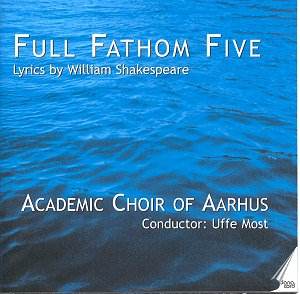Shakespeare is the theme and the range of response
he has drawn in the twentieth century from choral composers across Europe.
The settings are overwhelmingly tonal - nothing from the further reaches
of the Roundhouse this time! The forty strong mixed voice choir sound
well blended and are well up to the technical feats demanded. The choir
is recorded in a lively stone acoustic which accentuates the ethereal
and the fantastic. The part-singing remains lucid. I was introduced
to the Vaughan Williams piece by the Swingle II LPs issued in 1977.
There a far smaller ensemble of voices each of lustrous perfection carressed
the ear in a warmed balance that was closer to pop album than standard
classical. The Aarhus Choir have greater 'body' and are recorded in
a more naturalistic way. More muscular the sound may be but nothing
is sacrificed in terms of litheness and intonation. The Lutz recalls
the still terribly underestimated vocal writing of Geoffrey Bush (A
Summer Serenade is a masterpiece). It is a degree plainer than Vaughan
Williams fantastic flight in which Most resists the tempotation to hurry.
The Martin is taken from his opera The Tempest (1955) and revels in
a rather sober though highly skilled way. The Lindberg trio of songs
are a delightful discovery with O Mistress Mine (title carpe diem) flighty
and rapturous as also is the full-tioned Shall I compare thee. Crabbed
age and youth is wreathed in Delian sunset reflection and spiced with
medieval harmony - listen to the end of track 12. Jeppesen is less florid,
more angular though hardly avant-garde. In fact When Daisies Pied (tr
16) is melismatically playful. Mantyjarvi is straightforward in Come
Away Death but explores, twists and extrudes in Lullaby. Jazzy caribbean
restive in Double Double Toil and Trouble and then in Full fathom Five
dark green wrack magic as in the rvw setting with orthodox church. The
piano (played by Signe Buch So/rensen) puts in an appearance in an otherwise
a capela disc in Johanson's Fancies of which there are nine. The songs
are rather a cross between Godowsky, Lambert (Li Tai Po), Geoffrey Bush
and even Sondheim. Wonderful lean and poetic settings written within
a grand accessible style. Johnason has the knack of writing at a level
that exposes the natural musicality and shapeliness of the words. Now
we must look for British composers who set Danish words with such a
natural light-suffused talent.
The choir havea been well treated by the engineers
who have resisted the temptation to pull back on the levels at the power
of the climaxes whether in scimitar, granit or silky strength.
Altogether a pleasurable experience. I was especially
pleased to encounter the Johnason and the Linbdberg for the first time.
The Vaughan Williams recoridngs should be heard beyond these immediate
confines.
Rob Barnett
